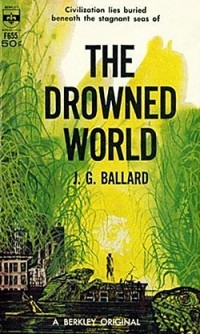25 Points: The Drowned World
 The Drowned World
The Drowned World
by J.G. Ballard
Berkley Books, 1962
208 pages / $23.95 buy from Amazon
1. “All the way down the creek, perched in the windows of the office blocks and department stores, the iguanas watched them go past, their hard frozen heads jerking stiffly. They launched themselves in the wake of the cutter, snapping at the insects dislodged from the air-weed and rotting logs, then swam through the windows and clambered up the staircases to their former vantage-points, piled three deep across each other.”
2. Freak extreme sunspot activity melts the polar ice-caps and reshapes the geography of earth. Humanity has migrated to the far north, and the cities of Europe are transformed into lagoons festering with lizards, mould, and ancient plant life. It’s the Triassic, part two.
3. The action focuses on two male biologists cataloguing new species in the lagoon that was once London, and a marooned heiress living in a half-flooded luxury apartment building. The biologists arrive with a military expedition charting the tributaries of the lagoon and surrounding islands. Despite the setting, it’s a boring premise, and it’s a relief when the main body of the expedition returns north.
4. Before the expedition leaves nearly everyone in the lagoon has started to dream about
a pulsing drum beat and “prehistoric sun”, which the biologists determine is a part of
“repressed” primordial memory, dating back to humankind’s earliest verterbrate
ancestors. #is is the main idea of the book. When I %rst got to this part I rolled my
eyes because it’s exactly that idea of “repressed primal drives” that I would expect was
trendy in the 60s and 70s (!e Drowned World was released in 1962). It reminded me
of the movie Wake In Fright, released in 1971, in which a prissy Australian schoolteacher
loses all of his money and basically gets his ass kicked by the Outback.
5. More things the idea of “repressed primal drives” reminded me of: “bogus ‘tribal’ art,”
“shag carpet,” “puma musk,” “gold medallions,” “whiskey,” “leopard print,” “snake
leather,” “open button-up shirts,” “Don Johnson’s alligator in Miami Vice,” “doing a lot
of cocaine,” “desperate misogyny.”
6. In Wake in Fright, the protagonist survives solely on the hospitality of strangers who
get him shitfaced and expect him to fire rifles while shitfaced. The movie is about a lot
of things, and it would be reductive to say otherwise, but contained within its premise
is the idea that there is a monstrous primal animal heart beating in the centre of
everyone. Wake in Fright handles this idea much better than The Drowned World: it’s
far more subtle, for one thing, which I think is partly due to the fact that it’s not
science fiction, although aside from its setting The Drowned World is not particularly
wild or exaggerated. And the Outback in Wake in Fright could almost pass for the
setting of a science fiction movie.
7. Wake in Fright’s excess is the result of despair or boredom whereas in The Drowned
World it is seen as a release or panacea.
8. As a title, !e Drowned World is almost too accurate, ultra-descriptive and relatively
bland, and the text doesn’t really exceed or challenge or stretch its boundaries. I don’t
think a work of fiction has ever delivered as well as The Drowned World does on the
implicit promises its title makes, and yet I’ve never been quite so disappointed. For a
post-apocalyptic wasteland, this was fairly standard fare, except perhaps for sections
like the passage I quoted in the first point.
9. “Drowned world,” “subconscious memories,” I get it, still boring.
10.Science fiction is, of course, always a better indicator of the time in which it is written
than that time’s future, but this book was too often derailed by its insistence on
remaining inside 1960s moral and social codes, as well as that time’s prejudices. This is
the main problem with The Drowned World. READ MORE >
June 13th, 2013 / 12:25 pm
